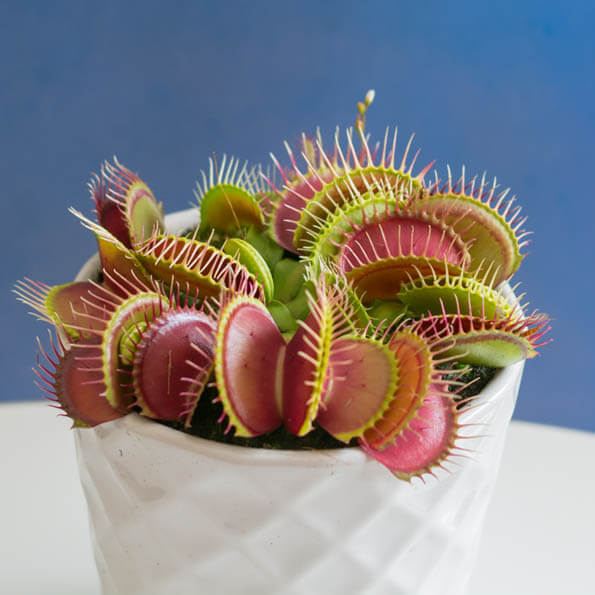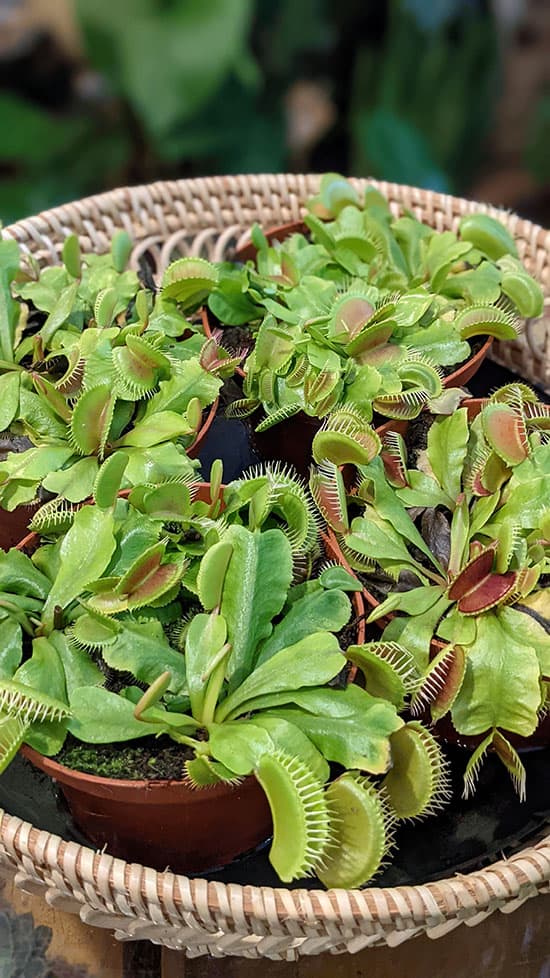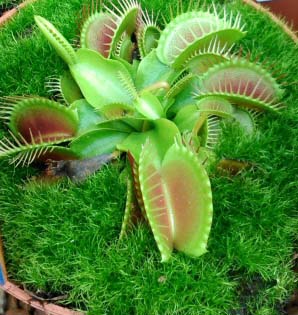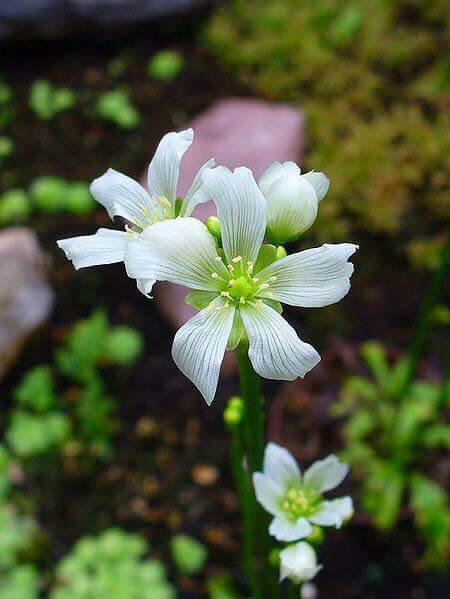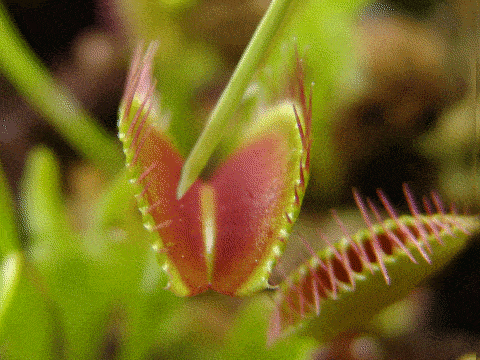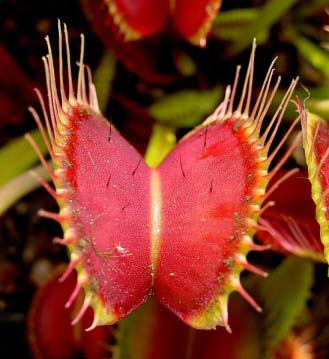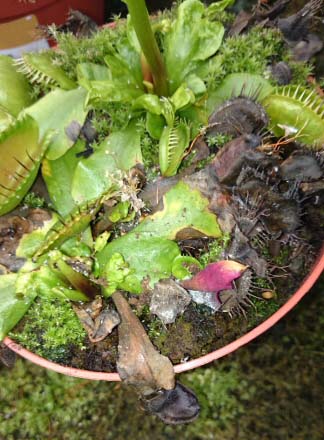Trying to grow a Venus Flytrap as a houseplant (which also goes by the name Dionaea muscipula) is something many people will have tried at one time or another. Although only a few of us will have kept it alive longer than a few weeks.
These are iconic houseplants, but can be tricky if the care they get isn't right. Photo by Mike Aronesty via Wikipedia
Let's be fair, we all know that the Venus Flytrap is well known for those fascinating traps that are just begging to be closed. A small carnivorous plant that reacts and moves in front of your eyes, it's no wonder we love them! So why do they do so poorly in our homes?
Despite their popularity the main reason they expire quite quickly in the hands of a lay person is the lack of correct care. We won't say they're simple plants to have around, but with some adjustment to how you might treat and care for a "normal" houseplant they can certainly live in your home or office longer than just a few weeks (up to 30 years actually!).
They can certainly live in your home or office longer than just a few weeks (up to 30 years actually!)
There is only the one species of Venus Flytrap, so although there are different varieties and cultivars you can get hold of, most need identical care requirements and will have quite similar growth patterns. The cultivars create individuality by their appearance, some have larger traps and others have different markings or colours.
However these are only likely to appeal to the seasoned collector due to the price they can command. Even standard Venus Flytraps can be expensive whereas the cultivars can fetch a great deal more, so as you might be able to predict this means these plants are sometimes difficult to find.
Taking stock so far, we've told you that Venus Flytraps are difficult to keep, expensive and hard to find. We haven't really sold the Dionaea muscipula to you have we!
They might not be everyone's cup of tea, but most people would agree they're interesting houseplants.
At the end of the day a lot of people have a soft spot for these quirky plants and you'll either love or hate the idea of them. The negatives might not be negatives depending on your perspective so once you have your new plant all you need to know is how to keep your Venus Flytrap alive, which we're talk more about later.
The main reason for failure is that these plants are typically a victim of their own popularity, it seems everyone out there has an idea about how a Venus Flytrap needs to be treated.
Some suggestions are correct and others total myths. Mess up on just one of the care requirements and you're potentially doomed. On top of that don't forget a rest is needed in Winter and you must understand the purpose of the traps and stop abusing them. Which leads us on nicely to the actual care instructions.

Hi, I'm Tom!
If you're like me and enjoy the challenge of growing houseplants and getting them to thrive, then Ourhouseplants can help. This website shares my knowledge and years of growing plants and provides (hopefully) helpful advice on properly caring for your indoor plant friends.
When you think of a Venus Flytrap growing natively you may think of a dank stinky bog with poor light levels. This isn't actually correct as natively this plant grows in much more exposed locations which receive large amounts of direct sunlight.
You need to fulfil the watering instructions below and if you do this, locations receiving direct sunlight are ideal. If you can't do this, find the brightest possible spot you have.
As with all houseplants, if your Venus Flytrap's previous home was very dark, plan its move to a spot in sunshine gradually, otherwise you risk burning the leaves to a crisp. Start with an hour of exposure a day, then build up over the following week or so.
If growing in direct sunlight, and in all seasons except Winter, it's very difficult to "over water" this plant. In fact you can quite easily leave it sitting in an inch of water in a drip tray from time to time.
This is obviously excellent news when you need to leave the plant over longer periods or you're naturally a bit unpredictable when it comes to watering your houseplants.
The soil can be allowed to become almost dry during Winter but this must be avoided at all other times. Moist soil, apposed to dry or wet soil, should be a consistent feature for your Venus Flytrap.
Very moist soil, should be a consistent feature for your Venus Flytrap in order for it to do well as a houseplant
Finally, you must not use tap water over a prolonged period. If you're desperate it will be okay on the odd occasion, but Venus Flytraps need pure water whenever possible. Tap water contains salts and other added minerals which although useful to human health are basically toxic to these plants as they make the water alkaline.
"Pure water" can be collected rain water, distilled or bottled water (it must have come from water sources not running through limestone. If in doubt use rain or distilled instead).
A small plant with moss growing around.
In very arid homes or offices crispy leaves can be the result which can make your Venus Flytraps look tatty.
The best and simplest way to provide sufficient humidity to keep your plant looking healthy is to use a drip tray and make sure there is water resting in it at least a few times a week. Some of the water will be used by the plant but also some will evaporate creating a small humid micro climate.
You should never feed a Venus Flytrap with houseplant fertiliser. It's not only unnecessary but potentially deadly. Being carnivorous they gather all the nutrients they need from the flies and other small insects they trap and digest.
Normal room temperatures are perfect. These plants can also deal easily with light frosts, anything more substantial however and you could be in trouble so do be careful if you choose to let it live outside during the Winter dormancy period.
The general rule is that you should look to repot your Dionaea once a year or once every two years in Spring or Summer. Unless your plant has outgrown it's existing pot there is no real need to upgrade to a new size, so essentially when we are repotting all we are doing is changing and refreshing the "soil" or growing medium it's been living in.
You must never use nutrient rich soil for your Venus Flytrap
To get started gently remove the plant and discard the old growing medium, take care not to damage the roots or rhizome as you do so. Fill the old (or new) pot with the fresh growing medium and then create a large enough hole to gently put the plant into. Once in place give everything a good soak (don't use tap water) to settle everything.
The tricky part is often finding suitable growing medium because you must not use nutrient rich soil like compost. This plant must grow in nutrient poor soil so if you give it something with fertiliser you will damage the roots and eventually destroy the plant.
There is lots you can use although normally you should be prepared to mix your own "blend". A mixture of two or more of the following is often used: Peat Moss, Spent Peat Compost (it must have been previously used and therefore drained of nutrients), Perlite, Sand, Vermiculite.
You should also be able to buy a ready made mixes. If you go down this route don't substitute for general houseplant purpose products and only buy clearly marked Venus Flytrap mixes.
You may think using Dionaea seed and growing them on is a good way to get more plants for a bargain price, but unless you are experienced with Venus Flytraps (in which case you probably won't need this article), our advice for beginners is - don't.
Germination can be hit or miss depending on the age of the seeds and they take a really long time to grow and mature. So our suggestion to propagate more plants? Cheat and buy fully mature plants through Amazon (or perhaps support your local garden nursery if possible).
Expect respectable growth in Spring and Summer if temperatures are warm, light levels are good and you water well. Even then these plants tend not to be fast growers.
Average height will only be a inch or so at most, unless you have a cultivar which has a more vertical growth habit. They often spread wider than they grow tall, at several inches across.
Flowers are quite common on Venus Flytraps, however they do not really add anything to the plant's appeal. Instead their presence is essentially a drain on resources and could hinder or adversely effect leaf and trap production.
Some people like to keep them in situ on established and mature plants, others will simply snip off the flowering stem once it emerges to divert energy back into the rest of the plant.
The blooms are not overly showy but are a fairly common sight with well cared for plants. Photo by H. Zell
It's not all bad news, because if you do get flowers then it's a great sign that you likely have a healthy plant and are looking after it well!
The Venus Flytrap is not considered toxic to pets or people.
It's good to rest a great number of houseplants over Winter, but this is absolutely essential for Venus Flytraps. You must rest your plant for around three months by providing cool to cold temperatures.
Find an unheated room, ideally one that does get cold such as a porch, conservatory or garage and reduce watering to just once or twice a month to keep the soil damp (obviously water more or less as needed to avoid the soil being too wet or dry).
Growth will almost stop completely, and parts of your plant will blacken and die (see picture further in the "help" section down for an idea of what to expect), do not be alarmed as come Spring when things get lighter and warmer, replacement growth will start.
The plant does ultimately need to catch pray in order to feed itself and prosper. You can of course attempt to feed it artificially, or the easier and natural way - just put it outside from time to time.
Animnation showing the flytrap closing - By Mnolf
The traps have hinges in the middle that allow it to snap close, much like you can slam a book shut when you balance the spine in the palm of your hand and push up.
The signal to the plant to close is when movement is detected on one of the trigger hairs found on the inside of the traps. The hair is touched and the trap closes.
If movement keeps happening within the trap at this point, for example if the insect tries to escape, the trap will keep closing trapping it's pray even tighter before it starts to consume what's been caught. Once it has eaten its meal the trap will reopen, often a week or so later.
Each trap has trigger hairs that need to sense vibrations before the leaf will close. Photo by Noah Elhardt
If movement ceases after the initial closure the plant will assume the pray has escaped or its been "tricked". The trap will then gradually reopen for future use.
The traps might look inviting to curious fingers (and whatever else can be used to poke the trigger hairs) but resist! Each trap has a limited life span which in part is determined by the number of closures that occur, after 4 or 5 closures the trap will become inactive.
Although they will still function like a standard leaf and carry out photosynthesis for the plant, it will no longer function as a trap.
Sick and dying looking Venus Flytrap
If yours looks like the one in the picture and Winter has just passed by then you can probably relax because if you've followed the instructions detailed above correctly this could very well be the result.
Once new growth starts as Spring takes hold you can carefully remove the dead leaves and traps. New growth will fill the spaces as time goes on.
This could be normal after a winter rest, but at any other time of the year it's a problem.
If this picture represents your plant at any other time of the year... You've got problems! Read this page in full and change whatever you're not doing. Don't despair - Recovery is always possible with these plants no matter how grim things look.
I didn't rest my plant over Winter
If we don't get a good nights sleep we perform poorly the following day and it's the same for these plants. If you don't rest your Venus Flytrap then you are putting it under a great deal of stress.
Come Spring growth may be poor, slower than usual or there may even be a greater susceptibility to disease and pests. Missing the odd year of Winter Rest in most cases won't finish off your plant, but miss it again the following year and you're pushing it.
I don't provide direct Sunlight or lots of Water
These plants don't give up and die right away if you don't provide good light or forget to water occasionally. However they need these requirements almost all the time, so slap your wrist and do better going forward. Remember the better you treat your plant the healthier it will look.
I used tap water on my Venus Flytrap
It should forgive the odd tap watering, but doing this regularly can harm your Dionaea and ruin the look of the leaves and limit growth.
If you're concerned flush the soil using pure water (rain, distilled or bottled water), this should help to wash out the minerals and salts the tap water will have introduced to the soil.
